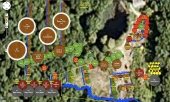I'd like to explane what patterns I'm using designing my food forest, and would appreciate any comment. My land Is already devided into logical parts, I'll skip that part, and try to draw only patterns itself.
I started with planting tall tree layer. Distance between them is (7m) 23 ft, and they will be pruned to fit in that space, and to let enough light to lower layers. And they are in triangular pattern:

I devided tall trees into some groups, mostly based on the size and growt habit, and genus also. I spread each group evenly across the garden so that I have apple tree in all parts of the garden, plum near every apple, cherry near every apple and plum etc.

Next I planted tall n-fixers. 3 n-fixers around each fruit tree, or 3 fruit trees around every n-fixer

They are here only temporarily, as a supporter for my young food forest, and will be cut down after several years. Maybe they will be used as coppice, but probably will be replaced with short trees.

Empty spaces will be filled with short trees. I consider short tree every fruit tree that I can pick from the ground or using small ledder, but at the same time the one that I can stand under it. The ones I can not stand under it, I consider shrubs. So, after filling empty spaces and replacing tall n-fixers with short trees, I have pattern like this:

Since a lot of short trees can be supporting ones, I decided 1/2 of short trees will be supporting trees like carragana (n-fixer), mulberry and elderberry (dynamic accumulators). Hope you still see triangles in lower image, I found out that as long I stay with triangles, each tall tree will get one carragana, one mulberry and one elderberry, and 3 fruiting trees around it, without any mistake.

Now I started to draw paths. I used leaves veins only as an idea. I can not just copy that pattern since I'm not water drop that needs to be delivered to one point of my garden. I want to walk through my garden, give a tour to my friends, when I'm picking elderberry flowers I want paths that are connecting them in time saving pattern, but also I don't want to use all available area for pathways. I drew some pattern like this, It has one big "road" running through the center of garden, big enough for a couple of people to take a walk without forming a caterpillar. Then, since terrain is sloped, I have main "branches" following contour lines. Size would be just enough that I can pass with a wheelbarrow without any problem. And then small branches connecting main branches, maybe just enough for a person to walk through without scraching against shrubs.

Then I would add shrub layer, without any plan yet, and a keyhole paths for servicing this shrubs, but I expect terrain itself will show me how to handle this once I come to that point.
What you think? This is just a pattern, this is not a plan of my garden (it is much bigger) but I found out that similar pattern can be applied to any size of garden, with some individualization, like ponds, playground, bigger spacing between trees etc.







 They are here only temporarily, as a supporter for my young food forest, and will be cut down after several years. Maybe they will be used as coppice, but probably will be replaced with short trees.
They are here only temporarily, as a supporter for my young food forest, and will be cut down after several years. Maybe they will be used as coppice, but probably will be replaced with short trees.
























 1
1









